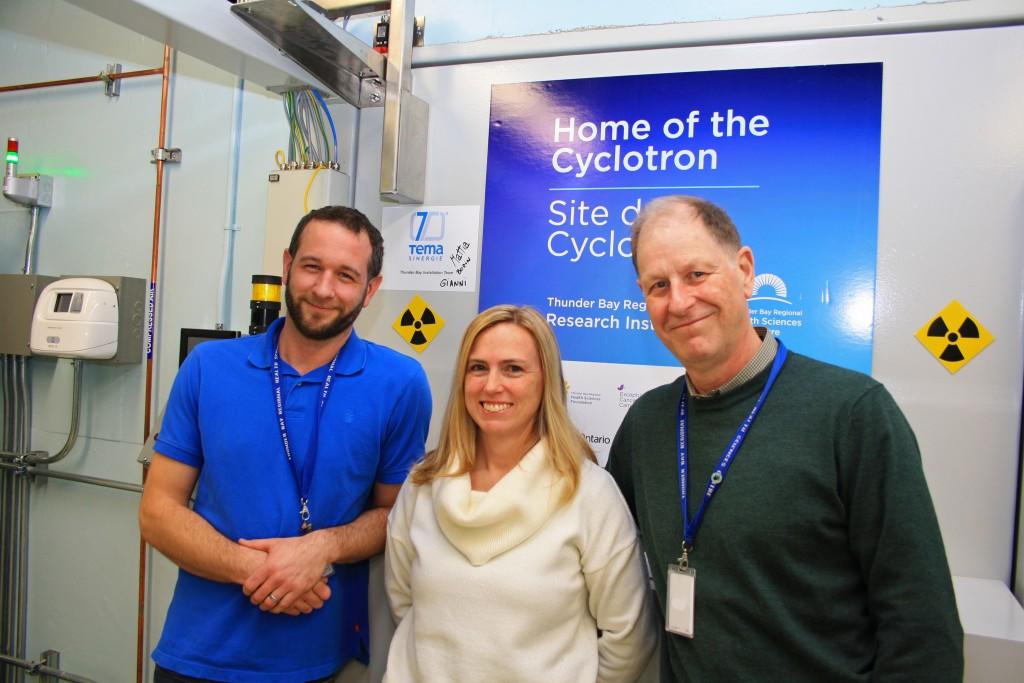Homegrown Cyclotron Program – and Team – the Real Success Story
by Graham Strong
 Stephen Exley (right), Interim Director of Cyclotron Operations, said that the real accomplishment is the homegrown program – one of the few hospital-based cyclotron programs in Canada. Dr. Jesse Walker (left) and Terry Fodë are part of the team that built the program essentially from the ground up.
Stephen Exley (right), Interim Director of Cyclotron Operations, said that the real accomplishment is the homegrown program – one of the few hospital-based cyclotron programs in Canada. Dr. Jesse Walker (left) and Terry Fodë are part of the team that built the program essentially from the ground up.The cyclotron passed a major milestone in 2016, delivering its first radioactive isotope (an atomic variant of an element) fluorine-18 for research and calibration purposes. Now, an application is pending with Health Canada to produce the radiopharmaceutical fluorodeoxyglucose or FDG for patient use. Stephen Exley, Interim Director of Cyclotron Operations, emphasized that the real achievement is the homegrown cyclotron program itself.
“The team has taken so much knowledge from other sources and brought it together to create this unique program,” Exley said. “The end product, FDG, is a relatively simple radiopharmaceutical that is extremely useful. But it’s the seven years of preparation including constructing the bunker and developing the program – that’s what people don’t always see. For this team to acquire all that knowledge and put it together is incredible.”
FDG is used to “light up” cancer cells during positron emission tomography (PET) imaging for cancer diagnosis, treatment planning, and treatment monitoring. Having a steady supply across the parking lot rather than across the province will reduce delays to patient care.
Thunder Bay Regional Health Sciences Centre is one of the first hospitals in Canada to build its own cyclotron program for patient care and research. It’s for that reason that there was no real blueprint for creating such a program. Terry Fodë, Project Support Officer, said that the public engagement piece of the Thunder Bay experience – which she spearheaded – will be used for current and future programs nationwide.
“The Canadian Nuclear Safety Commission (CNSC) deemed our public information program as a ‘gold standard’ and requested to use it as a template for the rest of the cyclotron facilities across Canada,” Fodë said.
What is perhaps most remarkable is the fact that most of the staff running this complex facility are from Thunder Bay. Given the technical expertise and knowledge needed, it is a testament to how far Thunder Bay has come, Exley said.
“You can see the growth and evolution of the people here to develop the program and facility,” he said.
One of those local people is Dr. Jesse Walker, a Cyclotron Associate and recent PhD graduate in Chemistry from Lakehead University. When he started his university career, there weren’t many opportunities in Thunder Bay in his field – he expected he would have to leave town. With the launch of the cyclotron program, Dr. Walker had the opportunity to stay at home.
“When I started in the PhD program, I knew it would be challenging to find a position in Thunder Bay,” Dr. Walker said. “I wanted to pursue a career that involved medicinal chemistry, so this really was a great fit for me.”
Cyclotron Associate Melissa Quance is also from Thunder Bay. Dr. Michael Campbell, who oversaw the cyclotron’s construction, is now the Lakehead University – Thunder Bay Regional Health Research Institute Research Chair in Radiochemistry and remains the program’s Radiation Safety Officer. In fact, only three staff members are not from the area: Fodë (though she has been in Thunder Bay for eight years), Sonja Desjardins, a Cyclotron Associate and the Deputy Radiation Safety Officer who is from Sudbury, and Bozin Nedanovski, the Cyclotron Equipment and Safety Systems Manager who is from Italy and came to Thunder Bay initially as part of the installation team. Most have science backgrounds including chemistry, physics, and biology, and each member of the team specializes in important areas of the cyclotron operation.
That’s just the tip of the iceberg. As production increases, more technicians will be needed, and there’s every expectation that these specialized jobs will be filled by local residents as well.
“All the knowledge that goes into producing radioisotopes was learned by local people,” Exley said.